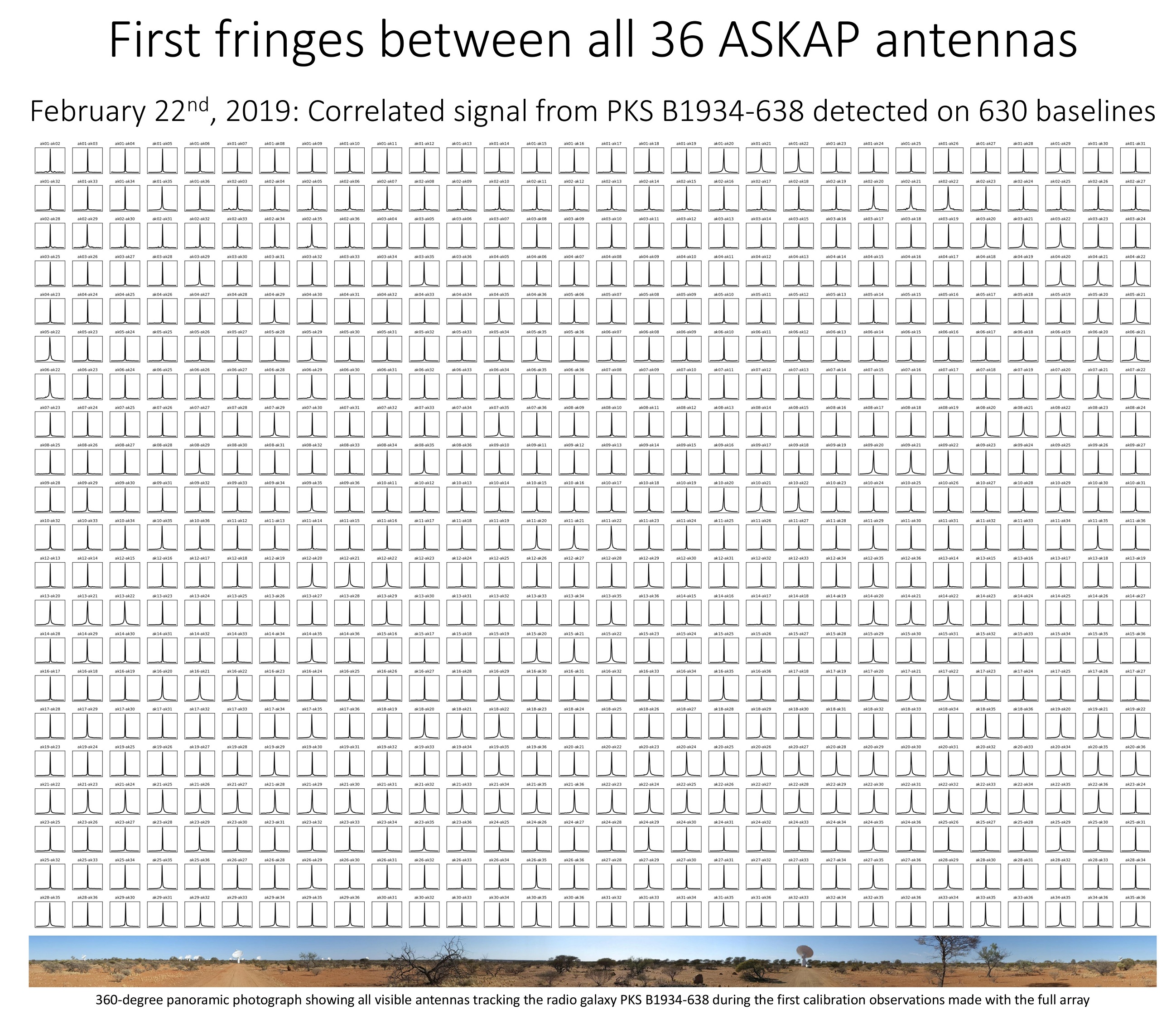ASKAP Antenna integration complete
Great news! Our Australian Square Kilometre Array Pathfinder (ASKAP) telescope is now operating with 36 antennas and we're on the path towards the launch of full survey science.
After many years of research and development, construction and commissioning, the full 36 dish array is online! Each antenna is now equipped with a CSIRO-designed phased array feed (PAF) receiver and linked to the bespoke digital signal processors and on-dish calibration systems.
On the 22nd of February 2019, we pointed all 36 antennas at an astronomical source and obtained interference fringes across the entire array, proving that all components work together as a single telescope (see the 'first fringes' image below).
The next 10 days were spent tracking calibrator sources in order to refine the coordinates of the antennas in preparation for imaging observations. Position measurements were done using a single beam, and towards the end of the commissioning session we started to record 36 beams. Some slight changes were made to the ingest pipeline to support the increased data rate from the full array and we now write 6 measurement sets per beam instead of 4, with 48 MHz of bandwidth in each. In this configuration we have demonstrated sustained ingest rates at Pawsey Supercomputing Centre of 1.8 GB per second using 10 second correlator cycles.

This successful integration of the last 8 antennas into the full array of 36, means we are now able to commence the exciting countdown to full survey operations. The commissioning of ASKAP 'survey mode' will follow a series of steps that test increasingly large aspects of the system (see the pathway outlined in the ASKAP countdown infographic).
Next, we are observing a series of test fields specified by the science teams with the goal of preparing for pilot surveys. These test fields exercise the modes of operation required for each survey, be it continuum imaging, spectral line imaging, transient detection and so on.
For the first time we will attempt to process all scheduling blocks using the ASKAPsoft pipeline and release images, catalogues and other data products from these test observations on the CSIRO ASKAP Science Data Archive (CASDA). This will confirm that we can provide the science teams with all data products necessary to achieve their goals.

Image caption: The countdown to ASKAP 36 full survey survey science is a campaign designed to share ASKAP's final commissioning sequence with the community, in the lead-up to full operations. As you might imagine, the process of bringing to life such a complex science instrument doesn't provide a single moment of victory but rather a series of exciting steps, building towards full capability. The nine stages on the countdown, show a sequence of increasingly complex operations. The milestones are being produced in turn by the ASKAP Survey Science Teams or CSIRO observatory staff.
Meanwhile, the science teams are busy planning their pilot survey strategies. Pilot surveys are designed to be a small slice of observing time used in a way that represents how the full, multi-year survey campaigns may proceed.
The ASKAP Commissioning and Early Science (ACES) team has also just released the Science Observation Guide, a document describing the telescope and its performance, which will be of great use to anyone planning observations with ASKAP or using data from the public archive.
At the same time, the ASKAP team is planning our first observatory project – a rapid survey of the Southern sky that will surpass any previously available data in ASKAP’s frequency range and provide a calibration reference for the future.
Although the telescope now has the majority of its planned capability, there is plenty of scope for upgrades. After the close of the commissioning project we will enter into a new extended modes project that will prioritise the many requests we have received for additional modes and capabilities. We will continue to develop the ASKAP image processing software and make it available to the wider community.
Congratulations to everyone who's worked on ASKAP and bringing this world-class fast survey radio telescope to life. It will enable breakthrough discoveries and be an important instrument on the global astronomy stage for decades to come. This is an exciting time for the project and all the astronomers who will soon be receiving their first data from the full-scale array.
See ASKAP and the other telescopes at CSIRO's Murchison Radio Astronomy Observatory on this great virtual tour https://virtualtours-external.csiro.au/MRO/

